#lipka tatar
Explore tagged Tumblr posts
Text

Lipka Tatar woman, Lithuania, by Linas Jegelevicius
#lipka tatar#tatar#europe#lithuania#eastern europe#folk clothing#traditional clothing#traditional fashion#cultural clothing
234 notes
·
View notes
Text
Biblioteka Tatarska — Library of the Polish Tatars

The website BIBLIOTEKA TATARSKA was created for readers at home and abroad: for all those who wish to learn more about the history, traditions, culture, as well as the contemporary reality of life of the Tatar-Muslim community in Poland.
The website belongs to the Supreme Muslim College, which is the executive body of the Muslim Religious Union in Poland. In addition to taking care of religious and doctrinal matters and working for the community, the College is also involved in cultural projects (e.g. publications, meetings, exhibitions, conferences). Since 2006, it has been active in journalism and publishing. Thanks to its dedicated team, magazines, books, brochures and CDs are produced to present and promote the history, tradition, culture and self-creation of the Polish Tatars. The materials are provided free of charge.
#lipka tatar#polish#poland#central europe#languages#sfl#sorry for the lowkey shitty screenshot i'm on my phone lol
7 notes
·
View notes
Text
What I love about Lithuania is that they make anyone feel like a part of the community, you don't feel like an outcast here.
It is even in the Lithuanian language. Not sure, but it seems like all the other countries call Jews just Jews, even Ukraine, and only Lithuania calls them Litvaki. "Lithuanian Jews". Not just the Jews but Lithuanian, they are part of our society, and they have the same rights and the same recognition as all the other Lithuanians. Same with Lipka Tatars - not just some random Tatars who happened to be here, not just the minority but the part of the community.
In conclusion, I love Lithuania
4 notes
·
View notes
Text


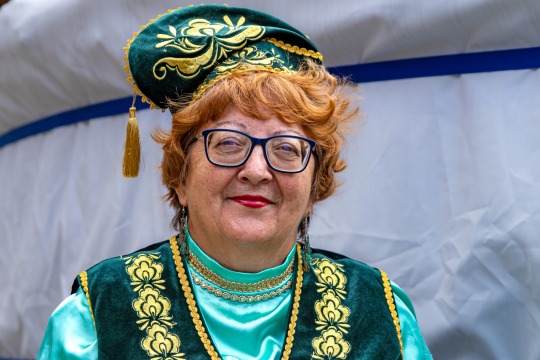



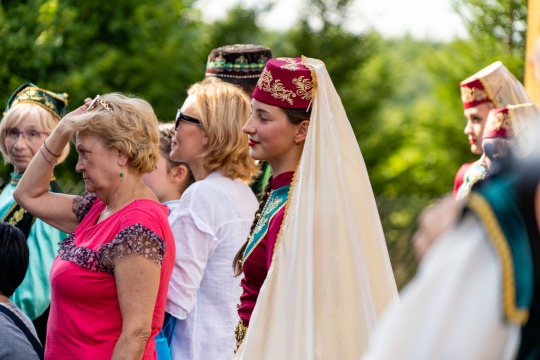
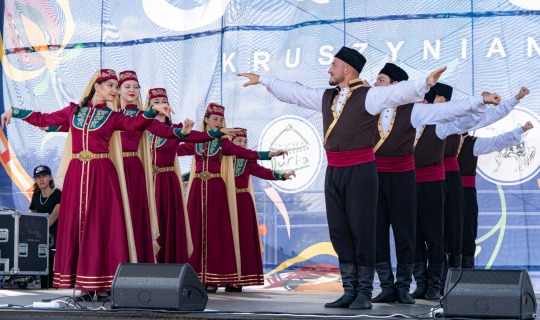
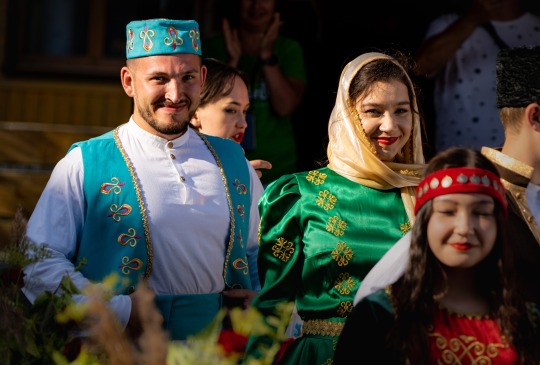

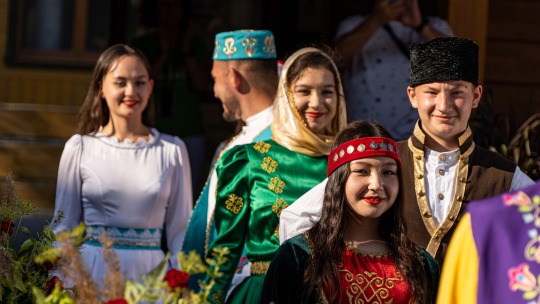
Poland's Muslim Lipka Tatars
Lipka Tatars are Poland's only remaining Indigenous Islamic group. Many of the Polish Tatars belonged to the Polish nobility historically and through out history have been one of the most loyal groups to the Polish state; also having had an influence on the general Polish culture.
Noted for their skills in archery and horse riding, they have been viewed as some of Poland's greatest warriors in the past. Their combat was essential in Poland's victory over the Ottoman Empire during the Battle of Vienna. This fact is contrary to recent western nationalist propaganda, stating that the war was a battle between Christendom and the Islamic world, rather than a war of imperialism. After the war King Jan Sobieski III granted the Lipka Tatars large pieces of land in the Podlasie region of Eastern Poland.
Their origins are in predominately male Crimean Tatars and other settlers from the Golden Horde, who relied on intermarriage with Christian women, leading to early partial assimilation and adoption of Slavic languages. However, they were able to keep their identity and parts of their culture through their ties to Islam. Regardless, over the centuries more and more Tatars were absorbed into the Polish-Lithuanian Common wealth's Catholic and Orthodox populations, with estimates in the 18th century stating that up to 25% of Muslims converted to Christianity- partially motivated by violent peasant drawback due to the privileges bestowed onto them. Eventually this absorption reached its height during the inter-war and post-World War II period of Poland, in part due to assimilative policies. These days most Lipka Tatar descedants simply identify as ethnic Poles, with many Poles not aware of their ancestry. A prominent example of this is Polish-American personality Martha Stewart who only recently discovered that she is of partial Lipka Tatar ancestry, after partaking in a television program dedicated to geneaology.
169 notes
·
View notes
Text
𝐠𝐥𝐞𝐧 𝐩𝐨𝐰𝐞𝐥𝐥 in 𝘢𝘯𝘺𝘰𝘯𝘦 𝘣𝘶𝘵 𝘺𝘰𝘶 ( 2023 ).
at 𝘵𝘩𝘦 𝘴𝘰𝘶𝘳𝘤𝘦 𝘭𝘪𝘯𝘬 𝘣𝘦𝘭𝘰𝘸, you will find #198 gifs of 𝐠𝐥𝐞𝐧 𝐩𝐨𝐰𝐞𝐥𝐥 ( 1988; polish, lipka tatar, english, welsh, german ). please 𝘥𝘰 𝘯𝘰𝘵 𝘴𝘵𝘦𝘢𝘭 or 𝘤𝘭𝘢𝘪𝘮 𝘢𝘴 𝘺𝘰𝘶𝘳 𝘰𝘸𝘯.



282 notes
·
View notes
Text
moŋsu jan / moñsu can
moŋsu jan / moñsu can / моңсу җан moŋsu jan is semi-phonetic, moñsu can is latin tatar script моңсу җан is cyrillic tatar script.

[id: a flag with three small aquamarine colored dark to light gradient stripes on top, a big beige stripe, and three small grape colored light to dark gradient stripes underneath] exclusively for tatar queer people. this includes all non perisex alloallocishet individuals who call themselves tatar, including kryashens, mishari, kazan tatars, lipka tatars, baltic tatars, qirim (crimean) tatars, seber (siberian) tatars, kasimov tatars, nokrat tatars, perm tatars, tiptars, nagaibaks, asterkhan tatars, mixed tatars, reconnecting tatars and more! moŋsu jan means "yearning soul", and both the term and the flag are designed to encompass all the yearning of queer tatars that came with anti-turkism and tatarophobia, the stereotyping of tatars as inherently anti-queer, the ostracization from tatar, turkic and indigenous communities due to queerness. this is also mean to encompass hope and willing to fight for better lives, for freedom and liberation. any tatars, but only tatars can use this. turanists and panturkists fuck off.
tagging @radiomogai
#kurchak's coining#flag coining#liom#label coining#liom coining#liom flag#liom safe#mogai coining#mogai flag#liom term#culturally exclusive
22 notes
·
View notes
Text
The Belarusian Arabic alphabet (Belarusian: Беларускі арабскі алфавіт, romanized: Biełaruski arabski ałfavit) or Belarusian Arabitsa (بَلاروُسقایا ارابیࢯا, Беларуская Арабіца, Biełaruskaja Arabica)[1] was based on the Arabic script and was developed in the 16th century (possibly 15th). It consisted of twenty-eight graphemes, including several additions to represent Belarusian phonemes not found in the Arabic language.
The Belarusian Arabic alphabet was used by the Lipka Tatars, who had been invited to settle in Belarusian territory, at the time part of the Grand Duchy of Lithuania. During the 14th–16th centuries they gradually stopped using their own language and started using the Old Belarusian language rendered in the Belarusian Arabic alphabet. Books of that literary tradition are known in Belarusian as Kitab (Belarusian: "Кітаб"), which is Arabic for written material.Example of text in Arabitsa
Some Polish texts were also written in the Arabic script in the 17th century or later.[2]
8 notes
·
View notes
Text
making a lipka tatar oc and what a beautiful history I’m researching tbh
2 notes
·
View notes
Text
Meduza's The Beet: Dispatch from Podlaskie
Hello, and welcome back to The Beet!
Eilish Hart here, the editor of this weekly newsletter from Meduza that brings you long-form journalism from across Central and Eastern Europe, the Caucasus, and Central Asia. If this email was forwarded to you, sign up here to join our mailing list. And be sure to check out last week’s feature about Nagorno-Karabakh’s tragic final act if you haven’t already.
As you may know, Poland is set to hold a doubleheader this weekend. The ruling Law and Justice party (PiS) has called a controversial four-question referendum for the same day as the October 15 parliamentary vote. Voters will be asked if they support dismantling border defenses and accepting “thousands of illegal immigrants from the Middle East and Africa” — the antithesis of the PiS government’s handling of the border crisis with Belarus since 2021. By all appearances, the ruling party designed the referendum questions to highlight key talking points in their campaign and to undermine their main rival: the opposition Civic Coalition led by former Prime Minister Donald Tusk. However, both the PiS and the opposition have been pushing anti-migrant rhetoric in their campaigns in an apparent attempt to outdo each other in what polling shows will be an extremely tight race.
And so, ahead of this weekend’s vote, we’re bringing you a bittersweet dispatch courtesy of journalist James Jackson, whom you may remember for his past work with The Beet on a borderless tripoint in Central Europe. This week, James takes us back to summertime in Podlaskie, a province in northeastern Poland that, in addition to sharing a highly fortified border with Belarus, is home to two Tatar villages. As the descendants of asylum seekers who settled in the region centuries ago, Podlaskie’s Tatars are living proof of Central and Eastern Europe’s diverse past — and, boy, do they have stories to share. Moreover, since 2021, these communities have experienced the border crisis firsthand and responded with compassion, distributing aid to stranded migrants and refugees and even conducting Islamic funerals for the deceased among them. I hope you find their story as fascinating as I did.
Dispatch from Podlaskie
In Poland’s Wild East, Tatar culture is alive and well
By James Jackson
There’s something ethereal about driving through the vast Polish region of Podlaskie in the summer. Best known for its bison and Żubrówka Bison Grass Vodka, this is Poland’s own Wild East, a frontier province along the reinforced border with Belarus. Yellow corn fields and seemingly endless rows of green pine trees punctuate its wide-open blue skies. Locals drink a moonshine called duch puszczy, “the spirit of the forest.”
Podlaskie even boasts its own historic horse-riding warriors, the Tatars, one of Europe’s oldest and one of the world’s most northern Muslim populations. With their wooden houses of worship, the Tatar villages of Bohoniki and Kruszyniany have the air of a little mosque on the prairie. Their cemeteries boast gravestones inscribed with novel-sounding Polish-Muslim names like Aisza Poltorzycka and Mustafa Bogdanowicz, alongside flourishes of Arabic and a smattering of Cyrillic lettering.

Kruszyniany Mosque, August 2022
GRZEGORZ GAJEWSKI / ALAMY / VIDA PRESS

JAMES JACKSON
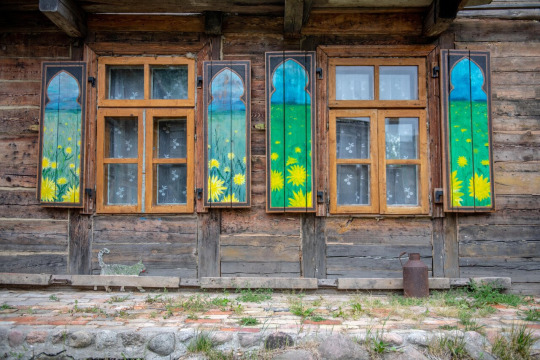
Painted wooden shutters on a wooden house in Kruszyniany. June 2018.
EDWIN REMSBERG / ALAMY / VIDA PRESS
Crimea’s indigenous Tatar population may be larger and better known today, but the Lipka Tatars were Muslim islands in interflowing Catholic and Orthodox seas spread across Poland, Belarus, and Lithuania before modern statehood. There are around 2,000 Tatars still living in Poland today, half in Podlaskie’s Tatar villages and the others scattered to the cities.
‘We don’t feel like outsiders’
In the Western imagination, Central Europe isn’t known for its diversity. Behind the Iron Curtain, everything was communist or Christian, gray with soot, and rife with decaying prefabricated tower blocks. But sitting down over a bright purple chłodnik soup of beetroot, cucumber, and eggs outside a colorful yurt in the Tatar village of Kruszyniany, these preconceptions seem far away.
As both the nationalist government and catch-all opposition take aim at migrants and refugees from the Middle East and Africa ahead of the parliamentary election on October 15, the Tatars serve as a reminder of a diverse and tolerant Poland that can sometimes be hard for modern observers to recognize.
Dżenneta Bogdanowicz runs a local restaurant and a visitor’s center with her husband. The Bogdanowicz family received this land hundreds of years ago as a gift from the legendary Polish King Jan III Sobieski for bravery in the Battle of Vienna. This battle looms heavily in nationalist myth-making as a time when the Polish Winged Hussars saved Christian Europe from the Turkic hordes of the Ottoman Empire. Some would perhaps rather forget that they fought victoriously alongside Muslim Tatars, just like they did in the Battle of Grunwald to throw off the yoke of the Teutonic order.
Bogdanowicz is a diminutive, effusive woman with a bowl haircut. As we eat, she chatters away in Polish, her first language. “The Polish Tatar language disappeared in the 16th century. Tatars are military men; they came to the area and married women, but children usually learn language from their mother, so that’s why the language disappeared,” she explains. “Many Tatar tribes didn’t have a common language, so they usually spoke the local language of where they were.”
Bogdanowicz’s family once owned 500 hectares (1,235 acres) of land in what is now Belarus, but it was lost in the great redrawing of Poland’s borders after World War II. Her grandfather fought for Poland in the war, following a family tradition of sorts. When he returned from exile in Britain on his wife’s orders, the Communist secret police hunted him down as a former Polish officer. He was kept in a prison camp in the center of Warsaw before he was executed in the 1950s.
She tells us this before instructing us on how to eat the traditional beef pie — “you cut the top off and eat it from the inside” — that she’s served alongside a babka ziemniaczana, a peppery potato cake with salty pickled cucumbers from their garden.
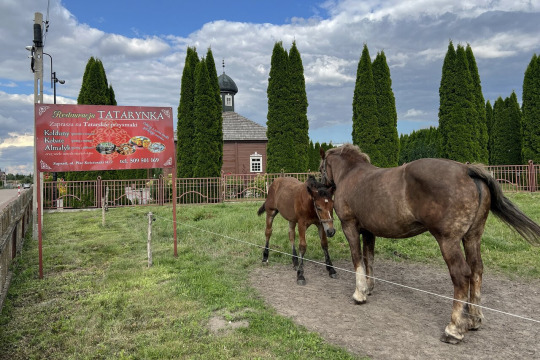
JAMES JACKSON
The Bogdanowiczs’ hospitality took a bittersweet blow five years ago. “We lost everything in a fire, even historical artifacts and souvenirs,” our host says, pointing to a freshly built wooden house that took the place of their burned home. But well-wishers from across Poland rallied to their aid. “We didn’t realize people even knew who we were, but many came to support us financially and mentally, as well,” she recalls.
“We don’t feel like outsiders,” Bogdanowicz adds. “Polish people see Tatars as equal citizens.”
The frontier of the Islamic world
“The Tatars are a remnant of an extremely multicultural world,” historian and Goodbye, Eastern Europe authorJacob Mikanowski tells The Beet. With nomadic origins as part of the Mongol Golden Horde, the Tatars were invited to settle in the region by a Lithuanian duke who granted asylum to Khan Tokhtamysh’s clan after they lost a war with the conqueror Timur in 1395.
At that time, the Grand Duchy of Lithuania — which later became part of the Polish-Lithuanian Commonwealth — was home to a wide range of ethnic and religious groups, including Orthodox Ukrainians and Belarusians, alongside Ashkenazi Jewish minorities, who would experience the Jewish Golden Age. Then, at the end of the 18th century, Poland-Lithuania’s more centralized and militaristic neighbors in Prussia, Russia, and the Habsburg Empire teamed up to extinguish this diversity and partition the commonwealth, spelling the end for what was once the largest state in Europe.
Nomadic fighters were an invaluable asset on this western edge of the flat Eurasian Steppe, and the Lipka Tatars often crossed sabers with Cossacks, Crimean Tatars, and Ottomans in service of the Grand Duchy of Lithuania and later the Polish-Lithuanian Commonwealth. In a prime position in the Bogdanowiczs’ kitchen, there stands a crescent-shaped standard bearer their ancestors carried centuries ago to fight for this flawed, unstable, yet precocious European republic.
“Eastern Europe is one of the frontier regions of the Muslim world,” Mikanowski explains. “We shouldn’t see it from just the West; you can change your perspective and equally well view it as one of the northernmost extensions of Islam.” Indeed, some Balkan countries have been Muslim longer than Latin America has been Christian, and Tatars have played a crucial role in Eastern European and Russian history.

The Muslim cemetery in Kruszyniany. October 2018.
TOUCH OF NATURE / ALAMY / VIDA PRESS
This consistent exposure to Islam led to one of the strangest trends in Polish history. From the 16th until the 18th century, members of the aristocratic Szlachta elite (who made up around 15 percent of the commonwealth, which by then they viewed as the bulwark of Christendom) started dressing in the Ottoman style and calling themselves Sarmatians, an ancient term for eastern European nomadic tribes taken from Ptolemy’s Geography.
Even when riding into battle against the Ottoman Empire, these nobles wore curved sabers, Turkic kalpak hats, and colorful Persian sashes. “When [Jan III] Sobieski was defeating the Turks during the 1683 Battle of Vienna, his Polish troops were dressed almost exactly the same way as their opponents,” writes journalist Marek Kępa.
As the only people able to vote under Poland-Lithuania’s Golden Liberty system (also known as the Nobles’ Democracy), the Szlachta relied on an imagined, ancient-Iranian warrior ancestry. “That was to differentiate the gentry from the peasantry. It was about being better than your serfs,” Mikanowski explains. Some nobles even saw the Tatars as their brethren — with the caveat that, as non-Christians, they were unsaved.
Doing something good
Though the Renaissance-era daydream of Sarmatism eventually died out, the Lipka Tatars did not, and they preserved their own traditions despite the disappearance of their language.
In the village of Bohoniki, half an hour’s drive from Kruszyniany, a wedding party gathers outside the community center while we wait for Maciej Szczęsnowicz, the chairman of the local Muslim community. As we sit down for tea across from the square brown house of prayer with its subtle minaret and red fence spiked with a crescent moon, the sounds of clapping and accordion music waft over to us, along with the scent of cardamom. The celebrants are dancing in a circle; among them is an older man who looks uncannily like a Tatar Lech Wałęsa.

Maciej Szczęsnowicz
JAMES JACKSON
Szczęsnowicz and his community attracted international attention in 2021 after Alexander Lukashenko’s regime tried to send tens of thousands of migrants and asylum seekers over the Belarusian border and into neighboring Poland. A humanitarian crisis ensued, with Polish border guards carrying out unlawful and sometimes violent pushbacks. The Polish government accused Minsk of waging a “hybrid war” and declared a state of emergency along the country’s eastern frontier, barring access to journalists and activists.
Szczęsnowicz, however, got permission from the Polish authorities to help the migrants, and he was one of the very few allowed to enter the tightly controlled border zone. Together with his community members, he began handing out 300 meals a day.
Some migrants didn’t survive the journey, succumbing to hunger, thirst, exposure, or injuries from beatings at the hands of border guards. That November, the Bohoniki Tatars conducted an Islamic funeral for 19-year-old Syrian Ahmed al-Hassan, who reportedly drowned in the river that runs along the Polish-Belarusian border. As the Imam read the rites, al-Hassan’s family watched via video link. “We wanted to spread the news that we were doing something good for people,” Szczęsnowicz tells The Beet.
Despite the bureaucratic hurdles in getting permission from embassies and the Polish authorities, Bohoniki’s Muslim community has held eight more funerals since then, burying the dead on the edge of their cemetery. The most recent ceremony took place in January of this year.
“They found him close to the Białowieża [Forest]. His brother came for the funeral, and so did the ambassador of Iraq,” Szczęsnowicz recalls.

Imam Aleksander Bazarewicz (center) says a prayer during the funeral ceremony of a 19-year-old Syrian refugee who drowned in the border river trying to get to Poland. Bohoniki, November 15, 2021.
WOJTEK RADWANSKI / AFP / SCANPIX / LETA
At least 49 people have died since the border crisis began, and more than 200 others are still missing. One body was found with a piece of paper that had the address of the Bohoniki community center written on it, Szczęsnowicz says.
The response to the funerals hasn’t always been positive, however. Szczęsnowicz has even received death threats, as well as offers of police protection.
Polish director Agnieszka Holland’s The Green Border, a film based on the true story of refugees stranded between Belarus and Poland in 2021, has met similar backlash — including from figures in the Polish government. Before the film’s premiere at last month’s Venice Film Festival, Justice Minister Zbigniew Ziobro likened it to Nazi propaganda. (The film won a special jury prize, and Holland filed a lawsuit against Ziobro for defamation.)
Though the crisis has somewhat abated, the electronic sensors on Poland’s newly constructed border wall registered 20,000 attempts to cross between January and August.
On election day, October 15, Poles at the polls will also take part in a national referendum, which will ask (among other things) whether they support the “admission of thousands of illegal immigrants from the Middle East and Africa” as part of the European Union’s migration pact.
The referendum is widely regarded as a way to boost turnout ahead of a tightly fought race where both sides have used immigration has as a rhetorical chess piece. How Poles respond may show how much of the commonwealth’s legacy lives on today. As loyal Muslim defenders of Poland and descendants of refugees, the Tatars will be watching.

JAMES JACKSON
That’s all for now!
For more of The Beet’s reporting from Poland, check out our March dispatch on how Ukrainian refugees were faring there after one year of all-out war. Until next time,
Eilish
4 notes
·
View notes
Text
The Belarusian Arabic alphabet (Arabica [arábitsa]) was brought into use in the 16th (possibly 15th) century by the (Lipka) Tatars, who had been invited (by Grand Duke Vitaŭt due to his treaty with khan Tokhtamysh) to settle in Belarusan territory, at the time part of the Grand Duchy of Lithuania. During the 14th–16th centuries they gradually stopped using their own language and started using the Old Belarusian language rendered in Perso-Arabic alphabet.

Books of that literary tradition are known as Kitab·s (Belarusian: “Кітаб”), which is the Arabic word for book. Kitabs contain Oriental legends, fables, adventure stories, descriptions of rituals, the so called “Meradj” (a poem about Muhammad’s ascension), narratives for young generation about moral and ethical behavior, fortune-telling on letters, interpretation of dreams. Apart from kitabs there also other related books: tefsirs (تفسير, Belarusan and Polish qur’anic parallel commentary), tejvids (تَجْوِيد, the rules of liturgical reading), hamails (special prayer books).
4 notes
·
View notes
Text
I'm actually interested in why people draw Liet with giant eyebrows. I mean- they're all Baltics, they're mostly blonde with giant baby cow eyes and wavy hair... unless he's Lipka Tatar, but they mostly live in Belarus and Poland nowadays?
#I have giant eyebrows because I'm Ukrainian - and let me tell you most of time they look pretty scary#and every time i try to use eyebrows pencil I look like goddamn brezhnev#I am 90% sure some of my ancestors were Tatars or someone because damn. not even Ukrainians have such thick eyes#i kinda hoped fashion on thick eyebrows would disappear and it did. because damn guys why do you hate your beautiful thin eyebrows so much
11 notes
·
View notes
Text
finding out you’re part lipka tatar is to polish like finding out your great great grandmother was cherokee is to americans from what i’ve gathered…
#poles really really really want to be the worlds most oppressed people at all times#okay time to go to sleep#sibay babbles at the void
1 note
·
View note
Photo
Please note the part about the Battle of Vienna.

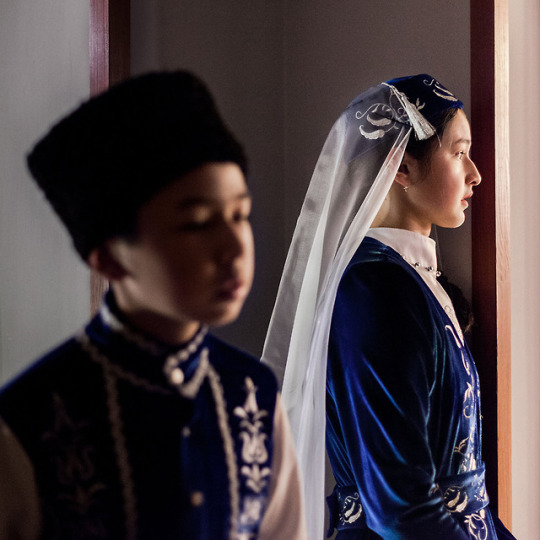


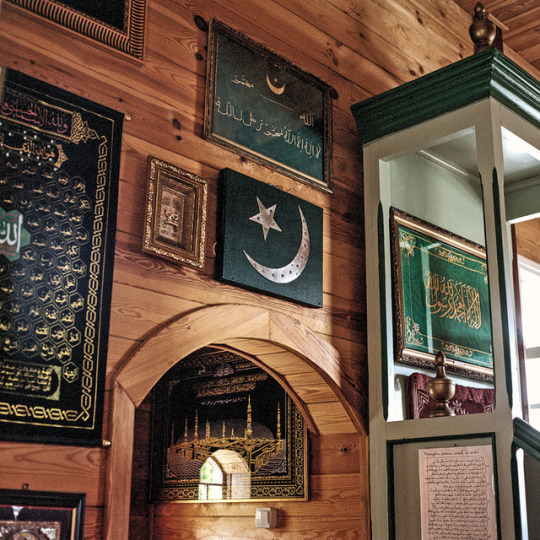

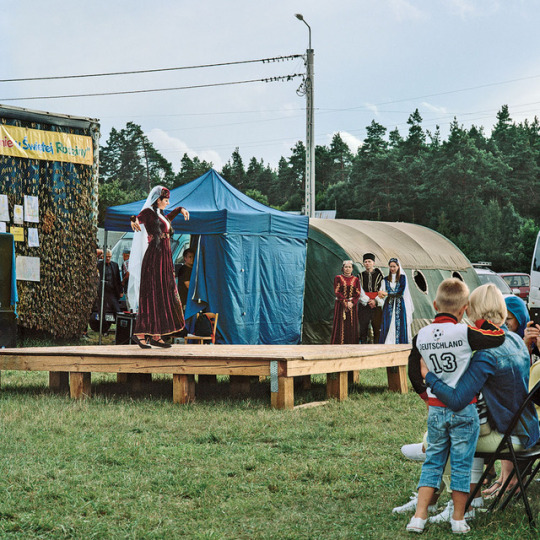


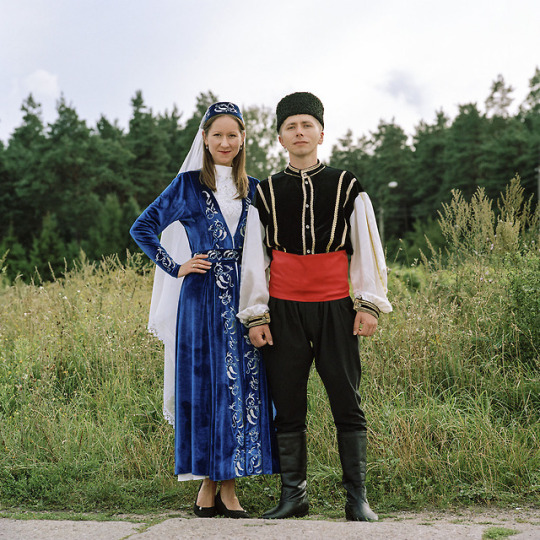
The Waning Crescent by Selim Korycki.
A photography project about the Polish Tatars, Poland’s oldest native Muslim population
The Podlasie region of North-Eastern Poland is home to the largest remaining population of Polish Tatars, also known as Lipka Tatars, a Sunni Muslim minority group that have resided in Eastern Europe for more than 600 years.
Their history in the region begins with Tokhtamysh, who was a prominent Khan of a subdivision of the Golden Horde, a Turkicized entity of the Mongol Empire. Tokhtamysh and his clan were granted asylum in the Grand Duchy of Lithuania by Vytautas the Great. At the beginning of its history the Grand Duchy, a Pagan ruled-state, had come to occupy parts of Poland, Belarus, and Ukraine. Being that it was a multi-ethnic and multi-religious entity ruled by a pagan leader, it developed an early history of religious tolerance as its Pagan leaders were not fond of the idea proselytism, being targets of it themselves by Christian missionaries and conquerors. Eventually the Grand Duchy would combine itself with the Polish Kingdom to create the Polish-Lithuanian Commonwealth.
For most of its history the Polish-Lithuanian Commonwealth upheld and legislated the previous values of the Grand Duchy of Lithuania. Due to these circumstances the Islamic population of the Commonwealth were allowed to mobilize in society freely and practice their religion without fear of persecution, unlike most other parts of Christendom. This religious freedom also brought about more Islamic settlers in the form of Crimean and Nogay Tatars, who would soon be absorbed into the general Polish Tatar population. The Tatars were also granted nobility status and frequently intermarried with the Polish nobility, however when this occurred it was mostly between those Tatars who converted to Catholicism or Orthodoxy and Christian Polish or Ruthenian nobles. Tatars remained a free people unlike the majority of the non-nobility Christian population in Poland who lived their lives as serfs. They were also permitted to own Christian serfs, again something not seen in most other parts of Europe.The Lipka Tatars were heavily valued as cavalrymen due to their horse-riding skills, and fought against both the Teutonic Knights and later the Ottoman Empire in the Battle of Vienna. despite the fact that this would ensure an Islamic expansion into the rest of Poland. Due to their intermingling with the Slavic and occasionally Baltic populations of the region they quickly lost their language, however other traits of their culture survived, particularly their adherence to Islam. Most Lipka Tatars adopted the Polish or Belarusian languages as their native tongue, but interestingly enough also used the Arabic script when writing those languages. Making them the only Slavic languages outside of Bosnian to have used that form of calligraphy. After the partition of Poland and eventually its independence, most Lipka Tatars ended up living between Poland and Belarus.
The Waning Crescent is a photography project created by Selim Korycki, who had this to say about it:
“Despite being brought up as an atheist, I was always very aware of my family history as well as the history of Lipka Tatars. Following many discussions about rising nationalism and Islamophobia, I realised just how very few people are aware of the Muslim community peacefully settled in the heart of Europe for over 600 years. Knowing that Podlasie region is the only place within today’s Polish borders where Tatars not only lived for generations, but are still present today I decided to execute the project there. This was my first visit to the region,”
Despite the Polish Tatars influence on Polish history and culture, there has been a lot of misunderstanding of the Tatars since the end of WWII when the country experienced great homogenization and radical assimilation, which increased under the Communist regime. When commenting on the views of many of his countrymen Selim said:
“There is a belief, for example, that Polish Tatars look like Mongolian nomads, that they speak ‘another’ language, and are generally un-Polish. In reality, after 600 years of assimilation, Poles of Tatar heritage are mostly [indistinguishable] from the rest of the population. Just as their parents, their grandparents and their great-grandparents they speak Polish, think Polish, feel Polish, have Polish surnames, eat Polish food.” At the same time Polish Tatars cultivate their culture by practicing Islam, preserving traditional Turkic names, and nurturing traditional Tatar cuisine (Central Asian dishes with Eastern European influence).
Today when less than 5% of the population of Poland consider themselves to be a member of an ethnic minority, and over 85% Poles declares themselves to be Roman Catholic; the Lipka Tatars are a striking reminder that Poland was once a hugely multicultural and multi-religious country”
5K notes
·
View notes
Text



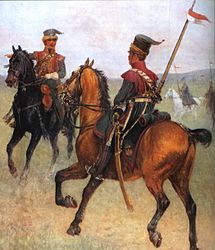




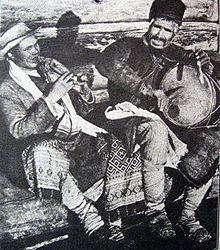
44) Tatarzy polscy, Lipka Tatars (Lipka – odnosi się do Litwy, zwani także Lipkowie, Lipkas, Tatarzy Litewscy, Lithuanian Tatars; później także – Polish Tatars, Tatarzy polsko-litewscy, Polish-Lithuanian Tatars, Lipcani, Muślimi, Lietuvos totoriai, Літоўскія татары– termin rozpowszechniony w okresie międzywojennym, określający Tatarów mieszkających na dawnych terenach Rzeczypospolitej Obojga Narodów. Dawniej nazywani również Tatarami litewskimi lub Tatarami litewsko-polskimi. Współcześnie mniejszość etniczna w Polsce.
Tatarzy osiedlali się w Wielkim Księstwie Litewskim od końca XIV w., głównie w okolicach Wilna, Trok, Grodna i Kowna, a od XVII w. także w Koronie, gł. na Wołyniu i Podolu, a u schyłku wieku na Suwalszczyźnie. Nazywano ich Lipkami lub Muślimami. Nazwa Lipki pochodziła od tureckiej nazwy Litwy. Najczęściej byli to uchodźcy polityczni należący do starszyzny tatarskiej Złotej Ordy i Krymu, przyjmowani szczególnie chętnie przez księcia Witolda i osadzani na ziemi jako ludność zobowiązana do służby wojskowej (na ogół w odrębnych chorągwiach tatarskich). Takim zbiegiem szukającym schronienia u Witolda był chan Złotej Ordy, Tochtamysz, który uciekł na Litwę przed swoim przeciwnikiem w 1395. W wyniku wypraw Witolda na Krym na Litwie osiedlono wielu Tatarów, sojuszników i jeńców, którzy zamieszkali wokół Trok oraz nad rzeką Waką. W 1409 na Litwę uciekli z wojskiem synowie Tochtamysza prowadzeni przez Dżalal ad-Dina, który walczył u boku Witolda pod Grunwaldem. W wojnie z Krzyżakami w 1414 brał udział tatarski oddział Betsub-ułana, młodszego syna Tochtamysza. W latach 30. XV w. emigracja tatarska przeżywała swoje apogeum. Tatarzy osiedlani byli w okolicach Trok, Wilna, Kowna, Lidy, Krewy, Nowogródka i Grodna. Osadnictwo zwiększali tatarscy jeńcy wojenni, którzy przez kolejnych władców osadzani byli we wsiach tatarskich na Litwie. Ostatnie grupy emigrantów politycznych z tatarszczyzny przybyły do Wielkiego Księstwa na początku XVI w. Otrzymywane przez Tatarów hospodarskich, czyli pochodzących z arystokracji tatarskiej, liczne przywileje zapewniły im zachowanie pewnej autonomii i muzułmańskiej religii. Rody (np. Glińscy, Szyryńscy, Barancewicze) otrzymywały herby i nadania ziemskie w zamian za służbę wojskową. Wraz ze starszyzną przybywali na Litwę tzw. Tatarzy-Kozacy, nienależący do rodów arystokratycznych, którzy parali się rolnictwem. Obie grupy otrzymały przywileje od Zygmunta II Augusta w latach 1561 i 1568, Stefana Batorego w 1576, Zygmunta III Wazy w 1609 i Władysława IV w 1634. Kolejną grupą społeczną byli płacący pogłówne tzw. Tatarzy miejscy, osiedleni na przedmieściach miast, których nie obejmowały królewskie i sejmowe przywileje. Według obliczeń historyków w XVI w. ziemie Wielkiego Księstwa zamieszkiwało 3000–4000 Tatarów. Na przełomie XV i XVI w. w wojsku polsko-litewskim pojawiły się pierwsze roty tatarskie. W wyniku wojen z Moskwą część Tatarów przeniosła się do dóbr magnackich na Ukrainie.
W II połowie XVII i XVIII w. szlachta tatarska w znacznym stopniu się spolonizowała, zaś Tatarzy w miastach ulegli wpływom białoruskim. W 1673, z powodu negowania ich szlachectwa, część Tatarów polsko-litewskich przeszła na stronę armii sułtana Mehmeda IV, jednak wkrótce większość z nich wróciła na stronę polsko-litewską. W wyniku postanowień rozejmu w Żurawnie, Lipkowie mieli wrócić pod panowanie tureckie. Osiedli w pobliżu Kamieńca Podolskiego, posiłkując załogę turecką przeciw Polsce. W okresie międzywojennym w granicach Polski żyło ok. 5,5 tysiąca Tatarów (województwo wileńskie, nowogródzkie i białostockie). Tatarzy zachowali odrębność wyznaniową, tradycję pochodzenia i obyczaje; działał Związek Kulturalno-Oświatowy Tatarów RP, Tatarskie Muzeum Narodowe w Wilnie, Tatarskie Archiwum Narodowe. W czasie II wojny światowej, Tatarzy ponieśli dotkliwe straty, szczególnie wśród inteligencji. Po wojnie w granicach Polski pozostały 2 wsie, które zachowały charakter tatarski; obie leżą w dzisiejszym województwie podlaskim (Bohoniki i Kruszyniany). Ponadto Tatarzy żyją rozproszeni w Gdańsku, Białymstoku, Warszawie i Gorzowie Wielkopolskim. Według narodowego spisu powszechnego 2011 narodowość tatarską zadeklarowało 1916 osób, z czego 665 jako jedyną. Od 28 grudnia 1925 działa Muzułmański Związek Religijny w Rzeczypospolitej Polskiej (obecnie z siedzibą w Białymstoku), a od 1992 Związek Tatarów Rzeczypospolitej Polskiej (z autonomicznymi oddziałami w Białymstoku i Gdańsku). Zwyczaje Tatarów zamieszkujących w dawnej Rzeczypospolitej zostały opisane m.in. w powstałym w roku 1558 Traktacie o Tatarach polskich.
Tatarzy to mniejszość etniczna, do której przynależność podczas przeprowadzonego w 2011 narodowego spisu powszechnego ludności i mieszkań zadeklarowało 1828 obywateli polskich (wg danych poprzedniego narodowego spisu powszechnego ludności i mieszkań z 2002 liczebność mniejszości tatarskiej wynosiła 447 osób), w tym: w województwie podlaskim – 539 osób (według narodowego spisu powszechnego ludności i mieszkań z 2002 – 319), mazowieckim – 332 (według narodowego spisu powszechnego ludności i mieszkań z 2002 – 22), pomorskim – 175 (według narodowego spisu powszechnego ludności i mieszkań z 2002. Tatarzy zamieszkują rdzenne kolonie tatarskie na Białostocczyźnie (Bohoniki i Kruszyniany) oraz miasta: Białystok, Sokółkę, Dąbrowę Białostocką, Warszawę i Gdańsk. Tatarzy w Polsce zatracili znajomość swojego ojczystego j��zyka, pozostali natomiast wierni religii muzułmańskiej. Istotne znaczenie w życiu mniejszości tatarskiej odgrywa działalność Muzułmańskiego Związku Religijnego w Rzeczypospolitej Polskiej. W 2023 r. ukazała się publikacja Stowarzyszenia Jedności Muzułmańskiej pt. Kęsim, kęsim czyli Urywki z najnowszej historii Tatarów i islamu w Polsce w listach Macieja Konopackiego do Mahmuda Tahy Żuka (1968-1977). TVP Białystok nadaje raz w miesiącu program o tematyce związanej z mniejszością tatarską zamieszkującą Podlasie pt. Tatarskie Wieści (dawniej w programie wszystkich mniejszości narodowych i etnicznych na Podlasiu pt. Sami o sobie). Najważniejsze tytuły prasowe to:
Rocznik Tatarów Polskich – rocznik
Przegląd Tatarski – kwartalnik
Życie Tatarskie – dwumiesięcznik wydawany w latach 1998–2017.
W 2021 na antenie TVP Dokument miała miejsce premiera 8-odcinkowego serialu dokumentalnego Tatarzy polscy.
Turecka grupa etniczna, która pierwotnie osiedliła się w Wielkim Księstwie Litewskim na początku XIV wieku. Pierwsi osadnicy tatarscy starali się zachować swoją religię szamańską i szukali azylu wśród niechrześcijańskich Litwinów. Pod koniec XIV w. kolejna fala Tatarów – tym razem muzułmanów – została zaproszona do Wielkiego Księstwa przez Witolda Wielkiego. Tatarzy ci najpierw osiedlili się na właściwej Litwie w okolicach Wilna, Trok, Grodna i Kowna, a później rozprzestrzenili się na inne części Wielkiego Księstwa, które później stały się częścią Rzeczypospolitej Obojga Narodów. Obszary te obejmują części dzisiejszej Litwy, Białorusi i Polski. Od samego początku osadnictwa na Litwie byli znani jako Tatarzy Lipccy. Zachowując swą religię, zjednoczyli swój los z losami przeważnie chrześcijańskiej Rzeczypospolitej Obojga Narodów. Od bitwy pod Grunwaldem, pułki lekkiej kawalerii lipsko-tatarskiej brały udział we wszystkich znaczących kampaniach wojskowych Litwy i Polski. Początki Lipków Tatarów sięgają potomków Państw Złotej Ordy, Chanatu Krymskiego i Chanatu Kazańskiego. Początkowo służyli jako szlachecka kasta wojskowa, ale później stali się mieszkańcami miast, znanymi ze swojego rzemiosła, koni i umiejętności ogrodniczych. Przez wieki stawiali opór asymilacji i zachowywali swój tradycyjny styl życia. Choć pozostali bardzo przywiązani do swojej religii, z czasem zatracili swój pierwotny język tatarski z grupy języków tureckich kipczackich i przyjęli w większości białoruski, litewski i polski. Na dzisiejszej Białorusi, Litwie i w Polsce nadal żyją niewielkie grupy Tatarów Lipkowskich, a także ich społeczności w Stanach Zjednoczonych.
Nazwa Lipka wywodzi się od starej krymsko-tatarskiej nazwy Litwy. Zapis nazwy Lipka w źródłach orientalnych pozwala wywnioskować o pierwotnym Libķa/Lipķa, z którego powstała polska pochodna Lipka, z możliwym zanieczyszczeniem w wyniku kontaktu z polską lipą „małą lipą”; tę etymologię zaproponował autor tatarski S. Tuhan-Baranowski. Rzadziej spotykaną polską formę, Łubka, potwierdza Łubka/Łupka, krymsko-tatarskie imię Lipków stosowane do końca XIX wieku. Krymsko-tatarski termin Lipka Tatarłar oznaczający Tatarów litewskich, później zaczął być używany przez Tatarów polsko-litewskich do określenia siebie. Religią i kulturą Lipkowie Tatarzy różnili się od większości społeczności islamskich sposobem traktowania swoich kobiet, które zawsze cieszyły się dużą swobodą, nawet w latach, gdy Lipkowie służyli Imperium Osmańskiemu. Normą była koedukacja dzieci płci męskiej i żeńskiej, a lipki nie nosiły welonu – z wyjątkiem ceremonii zaślubin. Tradycyjnie islamskie zwyczaje i praktyki religijne Tatarów lipskich zawierały także wiele elementów chrześcijańskich przyjętych podczas ich 600-letniego pobytu na Białorusi, w Polsce, Ukrainie i Litwie, zachowując jednocześnie tradycje i przesądy z ich koczowniczej przeszłości. Z biegiem czasu szlachta dolna i środkowa Lipka Tatarów przyjęła jako język ojczysty język ruski, a później białoruski. Jednak do lat trzydziestych XX wieku do pisania po białorusku używano alfabetu arabskiego. Wyższa szlachta Lipków Tatarów mówiła po polsku. W korespondencji dyplomatycznej między Chanatem Krymskim a Polską z początku XVI w. Polska i Litwa określane są jako „kraina Polaków i Lipków”. Już w XVII wieku w oficjalnych dokumentach Rzeczypospolitej zaczęło pojawiać się określenie Lipka-Tatar.
Migracja Tatarów na ziemie litewskie i polskie ze Złotej Ordy rozpoczęła się w XIV wieku i trwała do końca XVII wieku. Kolejna fala imigrantów tatarskich z Rosji nastąpiła po rewolucji październikowej 1917 r., chociaż składali się oni głównie z działaczy politycznych i narodowych. Według niektórych szacunków w latach 1590–1591 na terenie Rzeczypospolitej żyło około 200 000 Tatarów Lipków i służyło im około 400 meczetów. Według Risāle-yi Tatar-i Leh (tłum. Przesłanie dotyczące Tatarów Polskich), relacja o Tatarach Lipkowskich spisana dla Sulejmana Wspaniałego przez anonimowego polskiego muzułmanina podczas pobytu w Konstantynopolu w latach 1557–1558 w drodze do Mekki ) w Polsce istniało 100 osad lipsko-tatarskich z meczetami. Największe gminy istniały w miastach Lida, Nowogródek i Iwie. W Wilnie istniała osada Lipka Tatarska, znana jako Totorių Lukiškės, dzielnica tatarska w Trokach oraz w Mińsku, dzisiejszej stolicy Białorusi, znana jako Tatarskaja Slabada. W roku 1672 poddani tatarscy zbuntowali się przeciwko Rzeczypospolitej. Był to powszechnie pamiętany bunt Lipków. Dzięki staraniom króla Jana III Sobieskiego, cieszącego się dużym szacunkiem wśród żołnierzy tatarskich, wielu Lipków ubiegających się o azyl i służbę w armii tureckiej wróciło pod jego dowództwo i wzięło udział w zmaganiach z Imperium Osmańskim aż do Traktatu pod Karłowicami w 1699 r., w tym bitwa pod Wiedniem (1683 r.), która miała odwrócić falę ekspansji islamu w Europie i oznaczać początek końca Imperium Osmańskiego. Od końca XVIII i przez cały wiek XIX Lipkowie ulegali sukcesywnej polonizacji. Szczególnie klasa wyższa i średnia przyjęła język i zwyczaje polskie (chociaż zachowała islam jako swoją religię), podczas gdy warstwy niższe uległy rusinizacji. Jednocześnie Tatarzy darzyli wielkim szacunkiem wielkiego księcia litewskiego Witolda (po tatarsku Wattad, czyli „obrońca muzułmanów na ziemiach niemuzułmańskich”), który zachęcał i wspierał ich osadnictwo na przełomie XIV i XV w., m.in. wspomina się go w wielu legendach, modlitwach i ich folklorze. Przez XX i XXI wiek większość Tatarów nie postrzegała już tożsamości religijnej jako tak ważnej jak kiedyś, a podgrupy religijne i językowe znacznie się przemieszały; na przykład Tatarki w Polsce nie praktykują zasłaniania twarzy (noszenie chusty/hidżabu) ani nie postrzegają tego jako obowiązkowego obowiązku religijnego, ale raczej wpływ kultury arabskiej na zwyczaje islamskie. Alkohol pije także wielu polskich Tatarów, zwłaszcza i głównie młodzież.
Oś czasu:
1226: Powstaje Chanat Białej Ordy jako jedno z państw-następców imperium mongolskiego Czyngis-chana. Pierwszy chan, Ordy, był drugim synem Jochi, najstarszego syna Czyngis-chana. Biała Orda zajmowała stepy południowo-syberyjskie od wschodu Uralu i Morza Kaspijskiego po Mongolię. 1380: Khan Tokhtamysh, dziedziczny władca Białej Hordy, przekroczył Ural na zachód i połączył Białą Ordę ze Złotą Ordą, której pierwszym chanem był Batu, najstarszy syn Jochi. W 1382 roku Biała i Złota Orda złupiła i spaliła Moskwę. Tochtamysz, sprzymierzony z wielkim zdobywcą Tatarów ze środkowej Azji, Tamerlanem, ponownie umocnił władzę mongolską w Rosji
1397: Po serii katastrofalnych kampanii wojskowych przeciwko swojemu byłemu protektorowi, wielkiemu tatarskiemu wodzowi Tamerlanowi, Tokhtamysh i resztki jego klanu otrzymali od Witolda Wielkiego azyl oraz majątki i status szlachecki w Wielkim Księstwie Litewskim. Osiedlenie się Tatarów Lipków na Litwie w roku 1397 jest odnotowane w Kronikach Jana Długosza
1397: Włoskie miasto-państwo Genua sfinansowało wspólną wyprawę sił Chana Tochtamysza i wielkiego księcia Witolda przeciwko Tamerlanowi. Kampania ta wyróżniała się tym, że armie Lipków i Litwy były uzbrojone w pistolety, ale nie osiągnięto większych zwycięstw
15 lipca 1410: Bitwa pod Grunwaldem rozegrała się pomiędzy Królestwem Polskim i Wielkim Księstwem Litewskim z jednej strony (ok. 39 000 żołnierzy), a Krzyżakami z drugiej (ok. 27 000 żołnierzy). Krzyżacy zostali pokonani i nigdy nie odzyskali swoich dawnych wpływów. Po bitwie po całej Europie rozeszła się wieść, że Niemcy zostali pokonani dopiero dzięki pomocy dziesiątek tysięcy pogańskich Tatarów, choć prawdopodobnie w bitwie wzięło udział nie więcej niż 1000 tatarskich łuczników konnych, których trzon stanowiła świta Dżalal ad-Dina, syna Chana Tokhtamysza. Na początku bitwy Jalal ad-Din poprowadził lipskotatarską i lekką kawalerię litewską do samobójczego szarży na pozycje artyleryjskie Krzyżaków - pierwotna „Szarża Lekkiej Brygady”. W odpowiedzi wielki mistrz krzyżaków Ulrich von Jungingen rozkazał własnej ciężkiej kawalerii ścigać Lipków z dala od pola bitwy, depcząc przy tym ich własną piechotę. Wynikające z tego zniszczenie linii bitwy Krzyżaków było głównym czynnikiem ich późniejszej porażki. To wydarzenie stanowi jeden z głównych punktów filmu Aleksandra Forda „Krzyżacy” z 1960 roku, opartego na powieści historycznej pod tym samym tytułem autorstwa laureata Nagrody Nobla Henryka Sienkiewicza
1528: Prawo szlachty polskiej i litewskiej do zemsty za zranienie lub zabicie szlachcica lub członka jego rodziny zostaje rozszerzone na Tatarów Lipkowskich
1569: Na mocy unii lubelskiej zostaje założona Rzeczpospolita Obojga Narodów. Kompanie lekkiej kawalerii lipsko-tatarskiej przez długi czas stanowiły jeden z fundamentów potęgi militarnej Rzeczypospolitej Obojga Narodów. Tatarzy litewscy od samego początku swego pobytu na Litwie byli znani jako Lipkowie. Zjednoczyli swój los z losami Rzeczypospolitej Obojga Narodów. Od bitwy pod Grunwaldem brali udział we wszystkich znaczących kampaniach wojskowych
1591: Rządy gorliwego katolika Zygmunta III (1587–1632) i ruch kontrreformacyjny przyniosły szereg ograniczeń w wolnościach przyznanych w Polsce niekatolikom, m.in. Lipkom. Doprowadziło to do dyplomatycznej interwencji sułtana Murada III u króla polskiego w 1591 r. w sprawie wolności praktyk religijnych dla Lipków. Podjęto to na prośbę polskich muzułmanów, którzy towarzyszyli posłowi króla polskiego w Stambule
1672: Powstanie Lipków. W reakcji na ograniczenia swobód religijnych oraz erozję dawnych praw i przywilejów, pułki lipsko-tatarskie stacjonujące na Podolu w południowo-wschodniej Polsce opuściły Rzeczpospolitą na początku XVII-wiecznych wojen polsko-osmańskich, które toczyły się trwała do końca XVII w. wraz z traktatem karłowickim w 1699 r. Powstanie Lipków stanowi tło dla powieści Pan Wołodyjowski, ostatniego tomu historycznej Trylogii Henryka Sienkiewicza, laureata Nagrody Nobla (1905), który był sam był potomkiem schrystianizowanych Tatarów Lipkowskich. Film Pan Wołodyjowski z 1969 roku w reżyserii Jerzego Hoffmana z Danielem Olbrychskim w roli Azji Tuhaj-bejowicza do dziś pozostaje jednym z największych sukcesów kasowych w historii polskiego kina
1674: Po słynnym zwycięstwie Polski pod Chocimiem, Lipkowie Tatarzy, którzy zajmowali dla Turcji Podole z warowni Bar, zostali oblężeni przez wojska Jana Sobieskiego i zawarta została umowa, że Lipkowie wrócą na stronę polską pod warunkiem przywrócenia im ich starożytnych praw i przywilejów
1676: Traktat żurawski, który tymczasowo zakończył wojny polsko-osmańskie, przewidywał, że Tatarzy lipscy mieli mieć wolny, indywidualny wybór, czy chcą służyć Imperium Osmańskiemu, czy Rzeczypospolitej Obojga Narodów
1677: Sejm w marcu 1677 potwierdził wszystkie starożytne prawa i przywileje tatarskie. Tatarom lipskim pozwolono odbudować wszystkie swoje dawne meczety, osiedlić w swoich majątkach robotników chrześcijańskich i wykupować majątki szlacheckie, które wcześniej nie należały do Tatarów. Zwolniono także Tatarów Lipskich od wszelkich podatków
1679: W nagrodę za powrót do Rzeczypospolitej, Lipkowie Tatarzy zostali osadzeni przez króla Jana Sobieskiego w majątkach koronnych w województwie brzeskim, kobryńskim i grodzieńskim. Tatarzy otrzymali ziemię oczyszczoną z poprzednich okupantów od 0,5 do 7,5 km2 na głowę, w zależności od rangi i stażu służby
1683: Wielu powstańców lipsko-tatarskich, którzy powrócili do służby Rzeczypospolitej w 1674 r., miało później wziąć udział w kampanii wiedeńskiej 1683 r. Wśród nich znalazło się 60 Tatarów polskich z kompanii lekkiej kawalerii Samuela Mirzy Krzeczowskiego, który później ocalił życie króla Jana III Sobieskiego podczas fatalnego pierwszego dnia bitwy pod Parkanami, kilka tygodni po wielkim zwycięstwie bitwy pod Wiedniem, która miała odwrócić falę ekspansji islamu w Europie i wyznaczyć początek końca Imperium Osmańskiego. Tatarzy lipccy, którzy walczyli po stronie polskiej w bitwie pod Wiedniem 12 września 1683 roku, nosili w hełmach gałązkę słomy, aby odróżnić się od Tatarów walczących pod Karą Mustafą po stronie tureckiej. Lipkowie odwiedzający Wiedeń tradycyjnie noszą słomkowe kapelusze na pamiątkę udziału swoich przodków w przełamaniu oblężenia Wiednia
1699: Część Kamieckich Tatarów Lipkowskich, którzy pozostali lojalni wobec sułtana tureckiego, osiedliła się w Besarabii na pograniczu Imperium Osmańskiego i Rzeczypospolitej Obojga Narodów, a także w okolicach Chocimia i Kamieńca Podolskiego oraz na miasteczko zwane Lipkany. Kolejna emigracja Lipków na dużą skalę na ziemie kontrolowane przez Turków miała miejsce na początku XVIII wieku, po zwycięstwie króla Augusta II nad urodzonym w Polsce królem Stanisławem Leszczyńskim, którego Lipkowie wspierali w wojnie z królem saskim
1775: Polskie lipki wróciły do łask za panowania ostatniego króla Stanisława Augusta (1765–1795). W 1775 r. sejm potwierdził szlachecki status polskich Tatarów litewskich. Po rozbiorach Polski, Lipkowie brali udział w różnych powstaniach narodowych, a także służyli u boku Polaków w armii napoleońskiej
1919: Polscy Lipkowie dołączyli do nowo utworzonych formacji Wojska Polskiego; Pułk Jazdy Tatarskiej, a później 13 Pułk Ułanów Wileńskich
1939: Wraz z odrodzeniem się państwa polskiego po I wojnie światowej, w Wojsku Polskim ponownie utworzono polski pułk tatarski, który wyróżniał się własnymi mundurami i sztandarami. Po upadku Polski w 1939 r. polscy Tatarzy w 13. Pułku Ułanów stacjonującym w Wilnie (Wilno) byli jedną z ostatnich odnotowanych jednostek Wojska Polskiego, które pod dowództwem majora Aleksandra Jeljaszewicza walczyły z niemieckimi agresorami.
Obecnie na terenach dawnej Rzeczypospolitej żyje około 10–15 000 Tatarów Lipkowskich. Większość potomków rodzin tatarskich w Polsce może wywodzić się od szlachty wczesnej Rzeczypospolitej Obojga Narodów. Lipccy Tatarzy osiedlili się w północno-wschodniej Polsce, na Białorusi, Litwie, południowo-wschodniej Łotwie i Ukrainie. Obecnie większość mieszka w Polsce, na Litwie i Białorusi. Większość Tatarów lipskich (80%) zasymilowała się w szeregi szlachty Rzeczypospolitej, część Tatarów niższej szlachty zasymilowała się z białoruską, polską, ukraińską i litewską ludnością mieszczańską i chłopską. Wielu polskich Tatarów wyemigrowało do Stanów Zjednoczonych na początku XX wieku i osiedliło się głównie w północno-wschodnich stanach, choć jest też enklawa na Florydzie. W Nowym Jorku istnieje niewielka, ale aktywna społeczność Lipków Tatarów. „Islamskie Centrum Tatarów Polskich” powstało w 1928 roku na Brooklynie w Nowym Jorku i funkcjonowało do niedawna. Po przyłączeniu wschodniej Polski do Związku Radzieckiego w 1939 r., a następnie po II wojnie światowej, w Polsce pozostały tylko 2 wsie tatarskie: Bohoniki i Kruszyniany. Znaczna liczba Tatarów z terenów zaanektowanych przez ZSRR repatriowała do Polski i skupiała się w takich miastach jak Gdańsk (Maciej Musa Konopacki – patriarcha polskiego Wschodu), Białystok, Warszawa i Gorzów Wielkopolski, licząc w sumie około 3000 osób. Jedną z dzielnic Gorzowa Wielkopolskiego, w której osiedliły się przesiedlone rodziny tatarskie, zaczęto nazywać „Wzgórzami Tatarskimi” lub po polsku „Górkami Tatarskimi”. W 1925 roku w Białymstoku utworzono Muzułmański Związek Religijny. W 1992 roku rozpoczęła działalność Organizacja Tatarów Rzeczypospolitej Polskiej z autonomicznymi oddziałami w Białymstoku i Gdańsku. W Polsce spis powszechny z 2011 r. wykazał, że 1916 osób deklaruje pochodzenie tatarskie. W listopadzie 2010 roku w portowym mieście Gdańsku odsłonięto pomnik polskiej ludności tatarskiej podczas uroczystości z udziałem Prezydenta Bronisława Komorowskiego oraz przedstawicieli Tatarów z całej Polski i zagranicy. Pomnik jest symbolem ważnej roli Tatarów w historii Polski. „Tatarzy przelewali krew we wszystkich powstaniach niepodległościowych. Ich krew wsiąkła w fundamenty odrodzonej Rzeczypospolitej” – powiedział podczas odsłonięcia prezydent Komorowski. Pomnik jest pierwszym tego typu pomnikiem wzniesionym w Europie.
0 notes
Text

Lipka Tatar duo, Poland, by Selim Korycki
#lipka tatar#europe#eastern europe#poland#folk clothing#traditional clothing#traditional fashion#cultural clothing
192 notes
·
View notes
Text
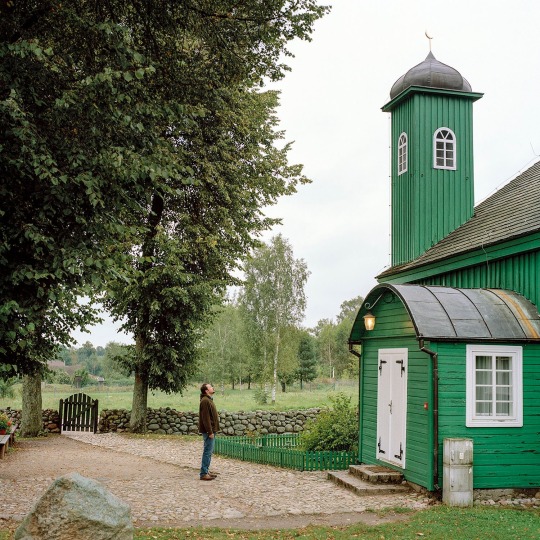



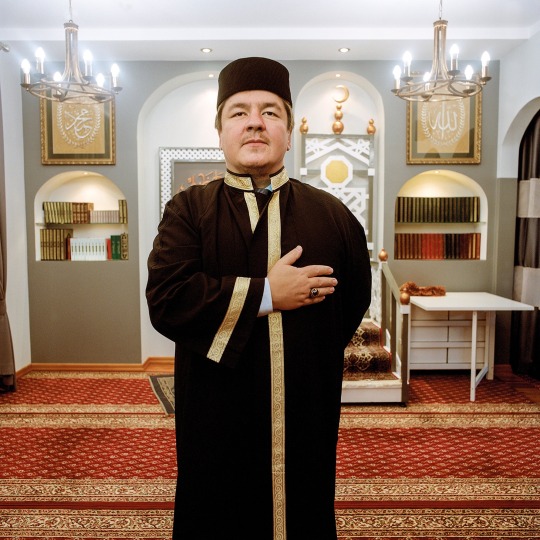

The Lipka Tatar community in Poland
115 notes
·
View notes